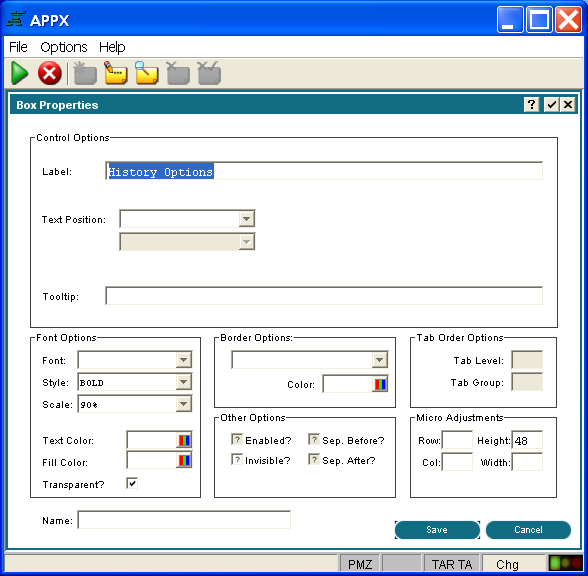Chapter 3-16: Using GUI Features of the Image Editor |
Painting Boxes After selecting the region in which you want your box or line to appear, as described in Painting Buttons, Labels, Pictures, and Boxes, the Box Properties overlay shown below appears. This example defines the "History Options" box shown further below. Box Properties Overlay for History Options Box History Options Box Control Options Label to define any text to appear as a box title. Text Position indicates where the text should appear inside the box border. Click the list Tooltip defines one line of help text that is displayed after the mouse pointer has been positioned over the box for a few seconds. Tooltip does not apply to boxes on output and inquiry images. Font Options Font selects the font (Arial, Courier, etc.) the box's label is to be displayed with. Click the list Style selects the label's font style (bold, italic, etc.). Click the list Scale defines the size of the label's font as a percentage of the runtime font size. Click the list Text Color defines the label's font color. Click the color icon to begin and see the Making Color Selections section for further instructions. Fill Color defines the region's fill color. Click the color icon to begin and see the Making Color Selections section for further instructions. Transparent? indicates whether or not the background of the region should be opaque or transparent. Border Options Type defines the type of border for the box. Click the list Color defines the color of the border. Click the color icon to begin and see the Making Color Selections section for further instructions. Tab Order Options Tab Level is not a valid option when defining a box and is disabled. Tab Group is not a valid option when defining a box and is disabled. Other Options Enabled is not a valid option when defining a box and is disabled. Invisible indicates whether or not the box is initially invisible when this image is first presented to the user. If 'yes' then the box must be made visible via ILF code in order for the user to see it. Click the checkbox to toggle between 'yes' Sep. Before? is not a valid option when defining a box and is disabled. Sep. After? is not a valid option when defining a box and is disabled. Micro Adjustments Row, Col, Height, and Width make slight adjustments to the size and position of the box. They are entered as a percentage of an image cell (1 row x 1 column) and must be less than or equal to 100. Name allows you to 'name' the box so it can be controlled (enabled, disabled, etc.) via ILF statements. Access to the GUI attributes at runtime with ILF code is done via the --- WIDGET file. The WIDGET records from the process are copied into this file and are available in the Pre-Display event point. WIDGET NAME is a key to this file. You can read and rewrite records in this file to affect the GUI attributes at runtime. When you have finished defining the box you have two options available to you: Select the Save option on the bottom right corner of the screen to save the definition and return to the Image Editor. Or, you can select the Cancel option to discard the new definition or changes to an existing definition, and then return to the Image Editor. |
Application Design Manual "Powered by Appx Software"1600 ©2006 By APPX Software, Inc. All Rights Reserved |


 button for a drop-down list of selections that include CENTER, TOP, RIGHT, BOTTOM, LEFT, UPPER RIGHT, UPPER LEFT, LOWER RIGHT and LOWER LEFT.
button for a drop-down list of selections that include CENTER, TOP, RIGHT, BOTTOM, LEFT, UPPER RIGHT, UPPER LEFT, LOWER RIGHT and LOWER LEFT.